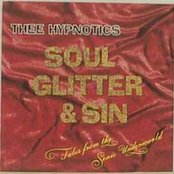Soul, Glitter & Sin

Biography
Assembling a host of 1967 psychedelic fuzz-guitar stars — Blue Cheer, Cream, Jimi Hendrix, etc. — as primary influences, adding a bit of Pretty Things/Rolling Stones ambience and jamming on a frenzied Stooges/MC5 drive, this quartet from High Wycombe, a town northwest of London, handily re-created the pre-Zeppelin era with more flair than most. Singer James Jones knows all the right moves, as does guitarist Ray Hanson, who pulls off the neat trick of overdubbing several different specific styles...
Assembling a host of 1967 psychedelic fuzz-guitar stars — Blue Cheer, Cream, Jimi Hendrix, etc. — as primary influences, adding a bit of Pretty Things/Rolling Stones ambience and jamming on a frenzied Stooges/MC5 drive, this quartet from High Wycombe, a town northwest of London, handily re-created the pre-Zeppelin era with more flair than most. Singer James Jones knows all the right moves, as does guitarist Ray Hanson, who pulls off the neat trick of overdubbing several different specific styles in a single song. Thee Hypnotics became a favorite of the fickle British music press with its first single, 1989's "Justice in Freedom," a stunning debut that, in both politics and volume, echoed the MC5, and by length (nearly nine minutes) hearkened back to the very early days of English metal.
The quartet — which also included drummer Mark Thompson and bassist Will Pepper — followed that with the solid "Soul Trader," then released the five-song Live'r Than God! in-concert EP, complete with an even longer version of "Justice in Freedom." Like most young bands with vigorous live reputations — and especially a group with a penchant for extended compositions — Thee Hypnotics' live sound doesn't translate well, nor is the recording quality particularly good.
It might not have mattered, had not Live'r Than God! become half of the band's first US issue, a live/studio summary of work to date. The four live tracks and four single sides make for a swirling carpet ride of electrifying nostalgia, effectively digested and powerfully delivered. For licensing reasons, the live "Justice in Freedom" was used rather than its clean and punchy studio counterpart, and the tapes sent to Sub Pop produced surprisingly tinny sounds. What had seemed full and rambunctious on English vinyl translated onto American CD as thin and more dated than it meant to be.
Though the band also encountered sound problems recording their first full-length studio album, Come Down Heavy (with new drummer Phil Smith) delivers what the title promises. With guest shots by Phil May and Dick Taylor of the Pretty Things (Rolling Stones contemporaries who know a thing or three about old-school grunge), Thee Hypnotics still sound like refugees from early-'70s Detroit — hard between the Stooges and Nugent — who've awoken two decades later with a bad hangover. The songs are tighter (not shorter), and Hanson plays as if he were the long-lost son of Peter Green.
Just as the cylinders seemed to be firing, Thee Hypnotics got into a car wreck while touring the States. In the aftermath, Robert Zyn was added on rhythm guitar. Soul Glitter & Sin (subtitled Tales From the Sonic Underworld) begins with the band's usual bang, but drifts into psychedelic lassitude, either heading off in too many directions at once or simply running out of ideas.
Three years later, with Zyn gone, a new label deal in hand and kindred raunch-rock revivalist Black Crowes singer Chris Robinson in the producer's seat, Thee Hypnotics made The Very Crystal Speed Machine. Ironically, working in a California studio with Americans (guitarist Marc Ford and keyboardist Eddie Harsch of the Crowes pitch in) leads the quartet to sound more like English antecedents (especially Free, Led Zeppelin and late-'60s Stones) than it ever has. A dubious achievement, to be sure, but the album completes Thee Hypnotics' transition from self-conscious fetishists aping a vintage sound to dedicated retroids ready to join the real things in the road-goes-ever-on trenches. And that's something to grow on.
Jones has most recently been active in a band called Black Moses.
Read more on Last.fm. User-contributed text is available under the Creative Commons By-SA License; additional terms may apply.
